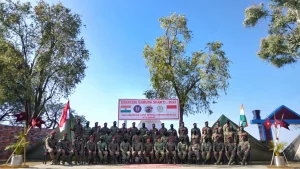Geomorphology is one of the most important topics in Physical Geography for the NDA and CDS examinations. It deals with the study of landforms, their origin, evolution, and the processes that shape the Earth’s surface. Understanding geomorphology helps in analyzing the dynamic relationship between geological structures and various natural forces like wind, water, glaciers, and tectonic activities.
NDA & CDS 1 2026 Exam Geography- Geomorphology
Meaning of Geomorphology
The term ‘Geomorphology’ comes from three Greek words —
‘Geo’ meaning Earth, ‘Morpho’ meaning form, and ‘Logos’ meaning study.
Hence, Geomorphology literally means “the study of the Earth’s landforms and surface features.”
Geomorphology explains how different landscapes such as mountains, valleys, plateaus, and plains are formed and transformed over time due to internal (endogenic) and external (exogenic) forces.
Forces Shaping the Earth’s Surface
1. Endogenic Forces (Internal Forces)
These are forces that originate within the Earth and cause large-scale changes in the Earth’s crust.
They are mainly responsible for mountain building, earthquakes, and volcanic activity.
Endogenic forces are divided into:
- Diastrophic Forces: Responsible for formation of mountains, plateaus, and continents through folding and faulting.
- Sudden Forces: Cause earthquakes and volcanic eruptions.
2. Exogenic Forces (External Forces)
These forces act on the Earth’s surface and modify existing landforms.
They include weathering, erosion, transportation, and deposition caused by natural agents like rivers, wind, glaciers, and sea waves.
Major Geomorphic Processes
1. Weathering
Weathering is the disintegration and decomposition of rocks in situ (without movement).
Types of weathering:
- Physical Weathering: Due to temperature changes, frost, or pressure release.
- Chemical Weathering: Due to oxidation, hydration, or carbonation.
- Biological Weathering: Caused by plants, animals, and microbes.
2. Erosion
Erosion is the removal and transportation of weathered material by agents such as rivers, wind, glaciers, and ocean waves.
3. Transportation and Deposition
After erosion, materials are transported and eventually deposited when the carrying power of the agent decreases, leading to the formation of plains, deltas, sand dunes, etc.
Agents of Geomorphic Change
1. Rivers (Fluvial Landforms)
Rivers shape valleys and plains through erosion and deposition.
- Erosional Landforms: V-shaped valleys, gorges, waterfalls.
- Depositional Landforms: Flood plains, deltas, ox-bow lakes, alluvial fans.
2. Wind (Aeolian Landforms)
Common in desert regions.
- Erosional Landforms: Mushroom rocks, yardangs.
- Depositional Landforms: Sand dunes, loess deposits.
3. Glaciers (Glacial Landforms)
Found in high mountain and polar regions.
- Erosional Landforms: Cirques, U-shaped valleys, fjords.
- Depositional Landforms: Moraines, drumlins.
4. Sea Waves (Marine Landforms)
- Erosional Landforms: Cliffs, sea caves, arches, stacks.
- Depositional Landforms: Beaches, spits, lagoons, bars.
5. Underground Water (Karst Landforms)
Formed in limestone regions due to chemical weathering.
- Features: Stalactites, stalagmites, sinkholes, and limestone caves.
Volcanism and Earthquakes
- Volcanoes: Openings in the Earth’s crust from which molten magma, gases, and ash erupt.
- Types: Active, Dormant, and Extinct Volcanoes.
- Example: Mount Etna, Mount Fuji, Barren Island (India).
- Earthquakes: Sudden shaking of the Earth’s surface caused by the release of energy from the Earth’s crust.
- Measured by Richter Scale (Magnitude) and Mercalli Scale (Intensity).
- Example: 2001 Bhuj Earthquake, 2015 Nepal Earthquake.
Mountains and Plateaus
- Mountains: Elevated landforms rising prominently above the surroundings.
Types of Mountains:- Fold Mountains – Himalayas, Alps.
- Block Mountains – Vosges (France), Satpura (India).
- Volcanic Mountains – Mount Kilimanjaro, Mount Fuji.
- Residual Mountains – Aravalli Range.
- Plateaus: Uplifted flat-topped regions (e.g., Deccan Plateau, Tibetan Plateau).
Importance of Geomorphology
- Helps in understanding landform evolution and natural hazards.
- Aids in mineral exploration and soil conservation.
- Essential for civil engineering, agriculture, and environmental management.
- Supports military and strategic planning, especially in mountainous and desert terrains.



















